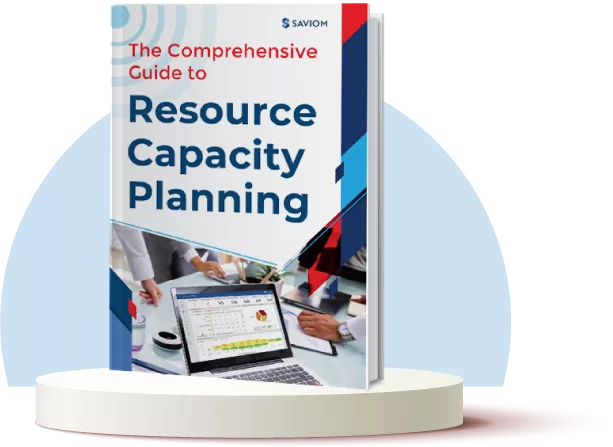Every project – big or small – comprises several moving parts like resources, materials, equipment, logistics, etc., and each element has a cost associated with it. Without a comprehensive view of all these expenses, preparing an accurate project budget becomes extremely difficult. This is where a cost breakdown structure (CBS) becomes indispensable.
A well-structured CBS helps you estimate all project-related costs, ensuring no element is overlooked. Without this approach, you might risk miscalculating the expenses, resulting in budget overruns, resource burnout, and ultimately, revenue loss for the company. Therefore, it is crucial to carefully estimate a project’s cost using a method like CBS that offers transparency and accountability.
In this blog, we will explore the cost breakdown structure and how managers can create one effectively to estimate project expenses accurately.
Let’s begin!
What is a Cost Breakdown Structure (CBS)?
Cost breakdown structure in project management is a comprehensive document that provides a hierarchical view of all project-related costs, including labor, material, overhead, etc. It breaks down the project expenses into smaller units that help the manager estimate all direct or indirect costs. It also offers a clearer picture of the financial requirements to complete the project, which helps prevent budget overrun in later stages.
Moreover, a cost breakdown structure complements a work breakdown structure (WBS) and is a key element of project management. It works at the task level and follows the bottom-up analysis, where the cost for each task is calculated first, and then the overall project budget is estimated. Using this approach, managers can even discover hidden costs and increase their likelihood of completing a project within budget.
Having explored the cost breakdown structure definition, we will now learn the different types of costs included in CBS.
What are the Costs Included in a CBS (Cost Breakdown Structure)?
As stated earlier, a project comprises several elements, and each of them incurs a cost. When combined, they form the cost breakdown structure of a project. Here are some of the most common costs that are included in the project cost breakdown structure:
Labor Costs
The labor or workforce is the backbone of any project. Hence, labor costs form the most significant share in the cost breakdown structure. These direct costs include your employees’ salaries, benefits, payroll taxes, and other expenses. Labor costs are calculated by categorizing them into job roles, experience, department, etc. Further, the overall cost is evaluated by estimating the number of hours required under each category.
Material Costs
Material costs include all the non-human elements essential for a project’s successful completion. These are direct costs for tangible items like raw materials, supplies, parts, and physical components. In a cost breakdown structure, these expenses are calculated by assessing the quantity of each material required throughout the project lifecycle and multiplying it by the unit price.
Equipment Costs
These costs include expenses incurred on equipment, machines, and tools required to develop or manufacture the final deliverable. For calculating equipment costs in a cost breakdown structure, project managers need to consider the initial price, leasing fees, repair, maintenance, and downtime costs. It is also essential to consider the labor required to operate the equipment.
Overhead Costs
Overhead costs are the ongoing or hidden expenses involved in a project. Initially, it might be challenging to estimate this cost as it cannot be allocated to a particular element in a project. However, they are one of the most significant expenditures that contribute indirectly to a project’s execution and delivery. These expenses include rent, utilities, electricity, internet, and even taxes.
Read More: Reduce Resourcing Cost by 10-30% with Modern Resource Management Solution
Travel & Logistics Costs
Some projects require moving people or goods from one place to another. In such cases, it is crucial to factor in travel and logistics costs. Travel expenses include transportation fare, accommodation cost, meal allowances, etc., while logistics costs include freight charges, custom duties, packaging, or storage expenses. These costs can add up significantly, so they must be considered in a project CBS.
Contingency Costs
Risk is an inevitable part of any project, and therefore, when preparing a cost breakdown structure, it is crucial to dedicate some funds to handling unforeseen events. Contingency costs help tackle unexpected expenses that may arise due to sudden scope creep, delays, and other uncertainties that can negatively impact the project’s budget.
Indirect Costs
In a project cost breakdown structure, indirect costs are those expenses that cannot be directly tied to the project but play a crucial role in supporting its successful execution. These costs include the workforce not directly involved in the project, such as HR, accounting, system admin, or management. Moreover, security measures, insurance, site supervision, etc., are also part of the indirect costs.
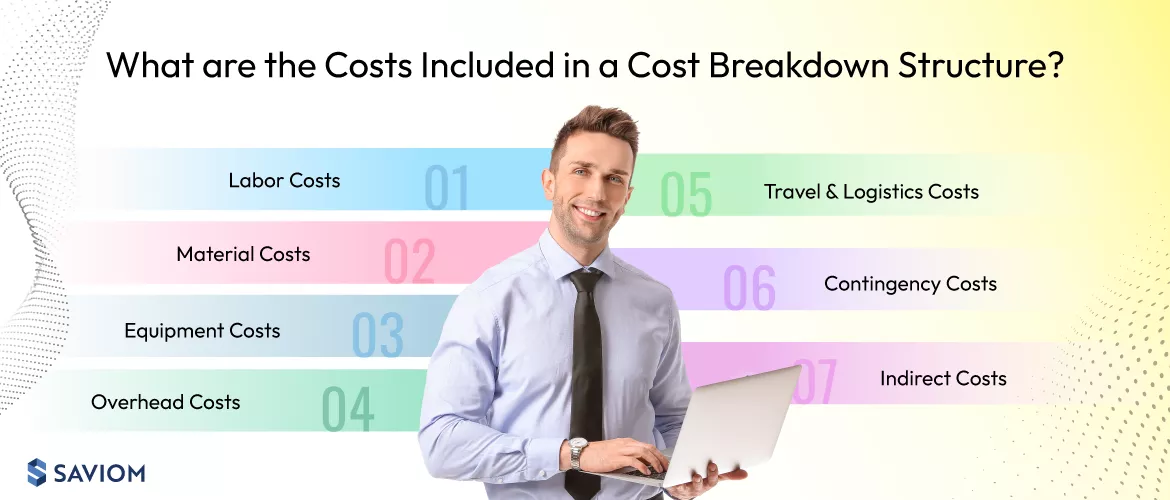
Read More: Project Cost Management: Types, Importance, and Steps to Calculate It
Let us now understand the cost breakdown meaning with an example.
Cost Breakdown Structure Example
To better understand what is the cost breakdown concept in project management, let us consider a construction project where a builder has received a contract for constructing a shopping complex. For estimating the cost of this project, the manager has to consider:
- How many laborers and senior technical staff are needed, and for how long?
- How much and what kind of materials and equipment are required?
- How to be prepared for storing or transporting the raw materials?
- What kind of site supervision is needed?
- What could be the possible contingencies for which some funds should be kept aside?
Based on this, the manager starts breaking down the project costs category-wise.
The manager estimates that to complete the project within the given timeline, the builder needs 100 laborers for 120 days, working 8 hours a day with an average hourly wage of $18.
The team plans to have 4 site engineers, 6 supervisors, and 2 safety officers working for the 6-month project duration with average monthly salaries ranging between $3,000 and $6,000. The manager prepares a complete breakdown of the labor costs:
| Role | No. of Workers | Duration | Hours/Day | Hourly Wage or Salary | Total Labor Cost |
|---|---|---|---|---|---|
| Laborers | 100 | 120 days | 8 | $18 (hourly) | 100 x 120 x 8 x 18 = $1,728,000 |
| Site Engineers | 4 | 6 months | 8 | $5,000/month | 4 x 6 x 5,000 = $120,000 |
| Supervisor | 6 | 6 months | 8 | $4,000/month | 6 x 6 x 4,000 = $144,000 |
| Safety Officers | 2 | 6 months | 8 | $3,500/month | 2 x 6 x 3,500 = $42,000 |
Therefore, the labor costs total around $2,034,000.
Next, the manager moves on to calculate material costs. He first lists all the raw materials required for the project.
| Material | Required Units | Price/Unit | Total Cost |
|---|---|---|---|
| Cement | 20,000 | $5 | $100,000 |
| Bricks | 50,000 | $1 | $50,000 |
| Steel | 60 tons | $500/ton | $30,000 |
Based on this breakdown, the manager concludes that materials will cost approximately $1,80,000.
Moving on, the manager estimates that to complete the project, the builder has to rent equipment like bulldozers, cranes, etc. He accounts for fuels, maintenance, and downtime and assumes the equipment cost will total around $120,000.
The manager now considers the travel and logistics costs. He knows a few senior staff will require accommodation near the site. Additionally, transporting heavy materials and equipment to the site is expected to cost around $50,000. A small storage area is also being rented for $1,000 monthly for 6 months, adding $6,000. So, travel and logistics, including staff lodging and transportation, are budgeted at roughly $100,000.
Apart from all the direct costs, the manager also accounts for indirect costs such as insurance premiums, administrative expenses, utility bills, and site security. Based on similar past projects, these are estimated at approximately $70,000. Finally, to handle any unexpected delays or price fluctuations, the manager sets aside 10% of the total estimated cost as contingency costs.
Putting it all together, the project budget based on the manager’s cost breakdown structure looks like this:
| Cost Category | Estimated Cost |
|---|---|
| Labor Costs | $2,034,000 |
| Material Costs | $1,80,000 |
| Equipment Costs | $120,000 |
| Travel and Logistics | $100,000 |
| Indirect Costs | $70,000 |
| Subtotal | $2,504,000 |
| Contingency Costs (10%) | $250,400 |
| Total Project Cost | $2,754,400 |
Read More: How to Develop an Effective Project Budget in 8 Simple Steps?
Having understood the cost breakdown structure example, let us see why CBS is important in project management.
Benefits of Cost Breakdown Structure (CBS)
“As companies grow from small to midsize, they inevitably arrive at a point where systematic cost analysis is critical to their survival and continued growth.” ~ Robert Sher, CEO, Mastering Midsized
This is why following an approach like CBS for project cost analysis is essential. Here are some benefits of cost breakdown structure in project management:
Provides Better Control Over Project Expenses
CBS allows you to break down project costs into smaller and more manageable components that provide complete visibility of all the project expenses. As a result, it becomes easier to monitor and control all spending during the project lifecycle. It also helps set a realistic spending limit for each component and allows you to enforce this during execution.
Improves Cost Estimations and Budgeting
A 2020 Project Management Institute (PMI) study revealed that over 60% of projects experience budget overruns, largely due to inaccurate cost estimates.
A cost breakdown structure helps solve this problem. CBS requires you to identify all project elements upfront and allocate costs accordingly. This eliminates any surprises in the later stages, as you have to set aside funds for every component or task of the project. As a result, the chances of inaccurate cost estimations or budget overruns are highly reduced.
Helps Detect Cost Deviations Early
A cost breakdown structure requires you to estimate and set spending limits during the project initiation. Therefore, during the execution, it becomes easier to detect any deviation. Moreover, you can compare the estimated against the actual cost and take corrective actions like reforecasting the budget to ensure efficiency without impacting outcomes, and keep the project on track.
Simplifies Financial Auditing & Reporting
A CBS provides a hierarchical and detailed report of all project expenses. This reduces time and effort for auditors to track project spending, compare it with the approved budget, and validate the accuracy of the financial records. Also, because CBS contains all the financial information at a granular level, it is easy to report any discrepancies and take necessary action in advance.
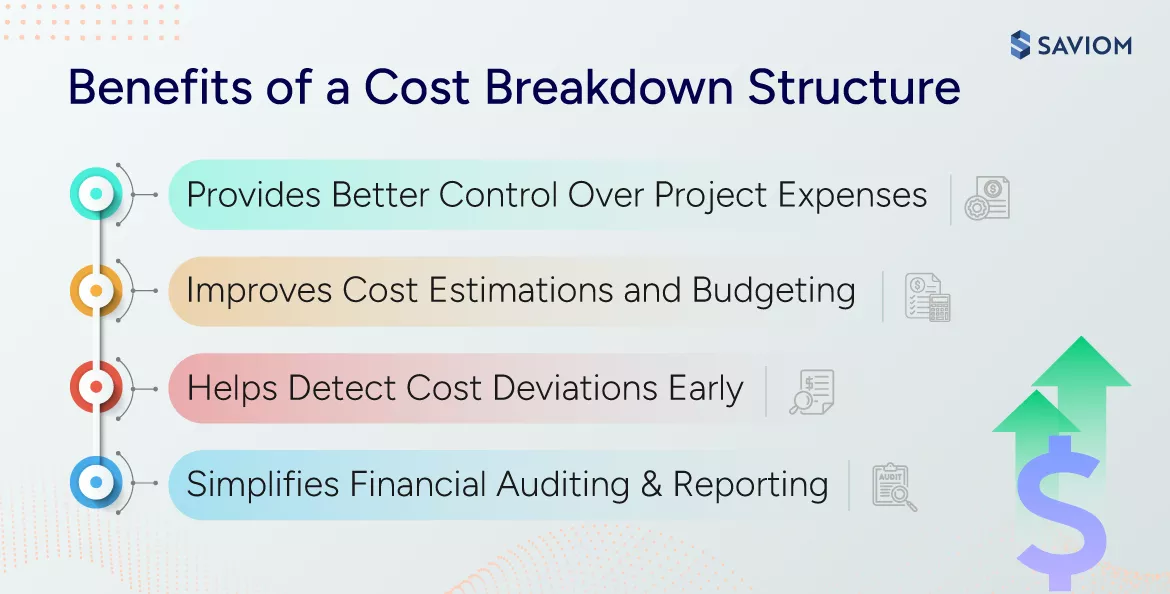
Read More: 12 Key Project Reports for Successful Project Managers
As stated before, the cost breakdown structure works closely with the work breakdown structure. So, let us understand their difference in the next section.
Cost Breakdown Structure vs. Work Breakdown Structure
We have already established the meaning of cost breakdown, and the following table clearly shows its distinction from a work breakdown structure.
| Aspect | Cost Breakdown Structure (CBS) | Work Breakdown Structure (WBS) |
|---|---|---|
| Definition | A hierarchical structure that organizes and estimates project costs. | It breaks down the project into small and manageable tasks or subtasks. |
| Focus | Project-related costs | Project activities, tasks, and deliverables |
| Purpose | Helps with cost estimation, budgeting, and financial control | Helps with project planning, defining scope, and managing tasks |
| Structure | Cost categories are organized in a hierarchical manner | Structures deliverables in a task-oriented hierarchy |
| Outcome | Detailed cost estimates | Complete view of all project tasks |
| Change Requirements | When cost estimations or budget changes | When the scope or deliverables change |
| Key Elements | Direct, indirect, and contingency costs | Tasks, subtasks, and milestones |
| Inputs | Requires inputs from the budgeting and finance teams | Requires inputs from stakeholders and project documents |
Read More: How to Build a Work Breakdown Structure? A Step-by-Step Guide
Now that we have explored what is CBS and WBS, let us learn how to create a cost breakdown structure effectively.
How to Create a Cost Breakdown Structure?
Let us understand how to make cost breakdown structure using a software development project as an example:
Define Project Scope
The first step while creating a cost breakdown structure is comprehensively defining the scope. This includes outlining the objectives, the required number and types of resources, project boundaries, timelines, etc. Defining the project scope is important as it provides the foundation for accurately estimating costs. It also ensures that you are factoring in all project elements to avoid any overlooked expenses.
For example, let’s consider a software development project. Its scope covers different phases like requirement analysis, UI/UX design, testing, etc. Every phase involves specific teams and activities, which means unique cost requirements like salaries, software licenses, testing tools, overheads, and contingency costs. With a well-defined scope, all expenses are evaluated accurately in the CBS during the project’s onset.
Create Work Breakdown Structure
After defining the project scope, the second step involves creating the work breakdown structure (WBS), which helps you outline project timelines, milestones, and deliverables in an organized manner. This, in turn, helps identify the components that contribute to the overall project cost. As a result, you can easily estimate and allocate the required funds for those tasks.
To understand this better, let’s consider the earlier example of a software development project. The WBS highlights major tasks like development, testing, deployment, etc. It also highlights the subtasks like front-end coding, API integration, unit testing, etc. Each of these subtasks requires specific developers and tools, which have associated costs. Thus, with a detailed view, project costs can be calculated more accurately and in an organized manner.
Identify the Cost Categories
The next step involves identifying the different cost categories for the tasks detailed in the WBS. These include direct costs like labor, material, equipment, overhead, etc., and indirect costs like insurance, administrative expenses, etc. This categorization helps group similar costs and avoid duplication. If needed, these costs can further be divided into sub-categories for ease and to ensure that no component is left out.
Continuing the same example, in the software development project, it is estimated that 5 software developers are needed to complete the project on time, out of which one is a contingent worker. Therefore, when creating CBS, the manager can keep the salary of permanent employees in the primary category and the cost of contingent workers in the sub-category. In this way, cost categorization provides greater clarity for budget planning and control.
Read More: What is a Contingent Worker? Examples, Benefits & Best Practices
Assign Cost Estimates to Each Project Activity
Once you have identified all the cost categories for your project cost breakdown structure, it is time to estimate costs for each project activity. To do this more effectively, you can use cost estimation methods like parametric, analogous, etc., that best suit your project. When the cost estimates are ready, you need to assign them to the corresponding tasks and sub-tasks defined in the WBS.
For example, in a software development project, the manager chooses the three-point estimation method to estimate costs for the development activity. Depending upon data availability, he can choose analogous estimation for tasks like UI design or parametric estimation techniques for testing based on the number of tests. Once he arrives at satisfactory conclusions, he can assign the estimates to the project activities.
Develop a Contingency Margin for Uncertainties
When preparing a cost breakdown structure, it is important to remember that no matter how careful you are, estimates can never be 100% accurate. Moreover, there can also be scenarios where there is a sudden change in scope, resource constraints arise, or any other uncertainty comes up that may affect your cost estimates. In these situations, it is necessary to allocate some contingency funds to your project.
For instance, in the same software development project, the manager anticipates a potential scope creep due to evolving client requirements. To address this, he decides to allocate a 10% contingency margin as a buffer. Similarly, considering contingent workers are involved, he can also factor in unavailability or increased fees. These contingency funds ensure the project stays on track even during uncertainties.
Validate the CBS and Share with Stakeholders
The last step is thoroughly reviewing and validating your cost breakdown structure. Double-check that you didn’t miss any vital information or haven’t over-/underestimated costs for specific components. It is also crucial to ensure that you have included all the categories specified in the WBS. Once CBS is ready, share it with your project stakeholders, gather their feedback, and make changes as needed.
For example, before finalizing the CBS of the software development project, the managers review it with the finance team and department heads. It is then noticed that the deployment costs were underestimated because third-party integration fees were not considered. Based on this, the cost breakdown structure is updated and validated again. Finally, it is shared with all key stakeholders to ensure transparency and alignment.
Read More: Who are Project Stakeholders? 7 Effective Ways to Manage Them
We have explored how to effectively create a cost breakdown structure. Let us now see how using a tool can make this process more seamless.
How Can an Advanced Resource Management Tool Help You?
Estimating costs is not easy, but this process can become simpler with the right tool on your side. Here is how advanced resource management software can help manage project costs effectively:
- The tool’s all-in-one resource planner offers a centralized view of all the resource (permanent and contingent) data, including cost. This visibility enables you to estimate the resource costs for your project accurately. It also comes equipped with the following features that further help in saving costs:
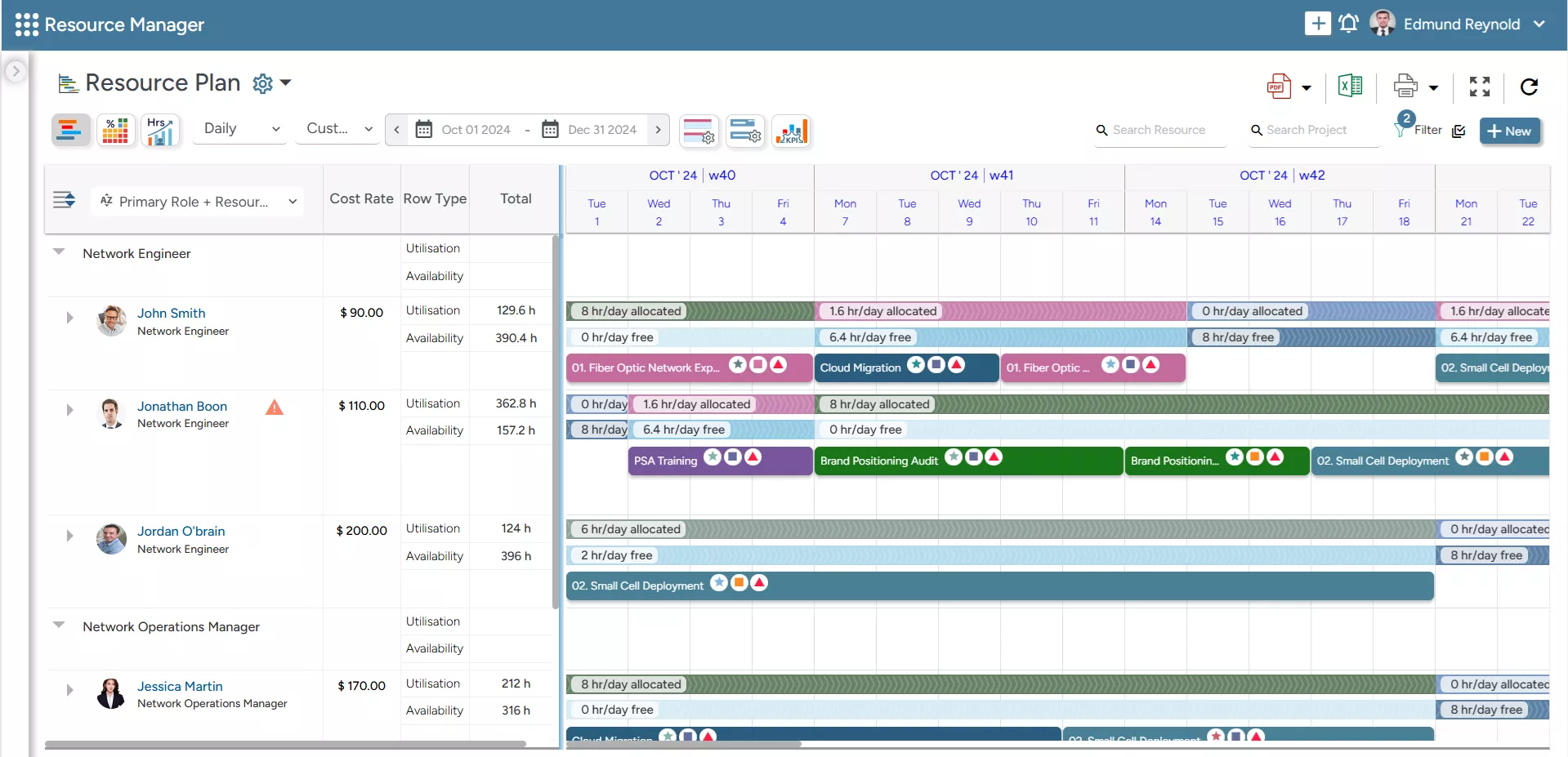
SAVIOM’s All-in-One Resource Planner offers 360-degree visibility of all resources, enabling managers to make informed decisions.
- The multi-dimensional analysis allows you to slice and dice resource data based on various dimensions like location, role, skills, cost, etc., helping you find the most cost-effective resource.
- With the embedded capacity planner, you can forecast resource shortages or excesses for your pipeline projects well in advance and take corrective actions if needed. In this way, you can avoid last-minute costly hiring or prolonged bench time, thereby reducing costs for your project.
- The intelligent match-making feature allows you to match the right person to the right task by finding the best-fit resource based on several parameters like cost rate, skills, availability, etc. This helps in avoiding costly mismatches that can escalate project expenses.
- The early warning system provides managers with alerts during instances of resource overloading, double bookings, etc. This helps in avoiding costly errors that can add to project costs.
- With the smart KPI forecaster, managers get real-time insights into key resource metrics such as resource overutilization/ underutilization, availability, etc. Therefore, managers can make informed decisions that help control project costs.
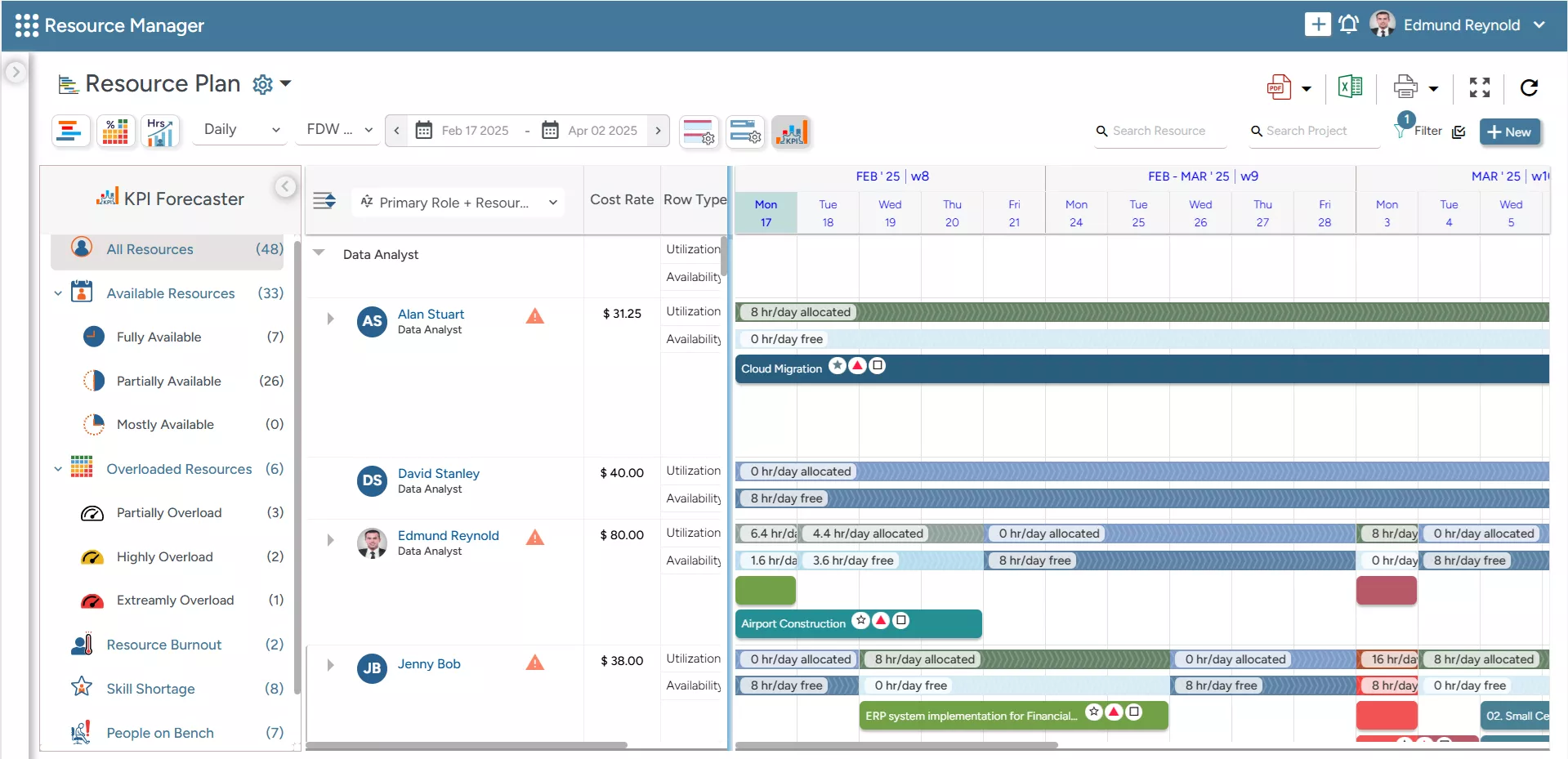
SAVIOM’s KPI forecaster helps managers track key resource metrics like utilization, availability, skill shortages, etc., in real-time.
2. The tool’s robust resource forecasting feature enables managers to anticipate future demands and take necessary actions. With the forecast vs. actual cost analysis, managers can quickly detect deviations from the cost breakdown structure. It also empowers you to compare the budgeted vs actual spending so that you can take corrective actions.
3. The tool comes equipped with real-time BI capabilities, which include various reports and dashboards. These provide real-time information to help you track and report costs, allowing you to validate your CBS with data-backed insights.
4. A Gantt chart visually represents all project interdependencies, enabling you to map each activity’s time-bound cost elements. It also helps you ensure synchronization between the WBS and CBS.
5. Lastly, the what-if analysis feature helps you plan for contingencies by modeling various scenarios like scope changes or resource unavailability. You can assess the impact of each scenario before finalizing the cost breakdown structure and have realistic numbers.
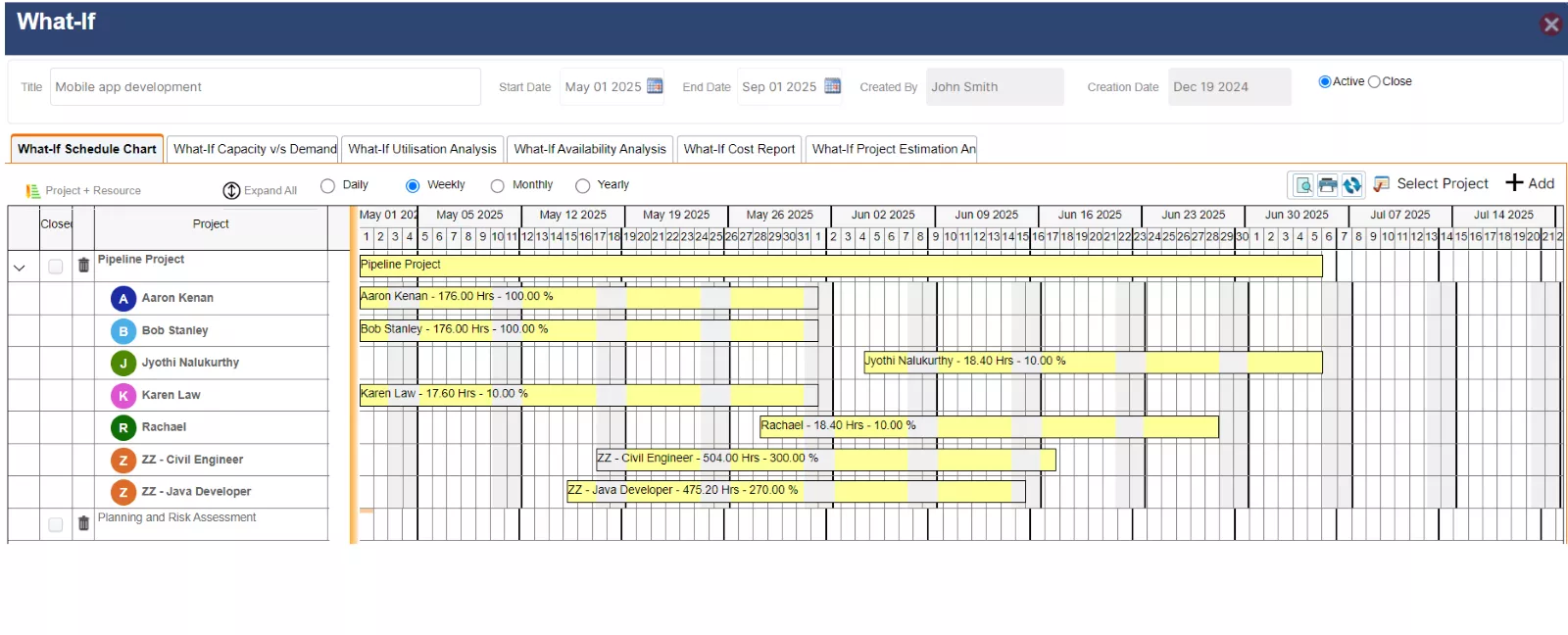 SAVIOM’s What-if Analysis feature allows managers to leverage scenario modeling in a sandbox environment to assess the impact of various decisions before finalizing the best-fit plan.
SAVIOM’s What-if Analysis feature allows managers to leverage scenario modeling in a sandbox environment to assess the impact of various decisions before finalizing the best-fit plan.
Key Takeaways: Additional Tips
The cost breakdown structure is an important part of project management. While it is a meticulous process, using the right method and tool can significantly streamline your efforts and improve accuracy. Here are some additional tips that can help you ensure your CBS is on point and remains dependable:
- Ensure full alignment with the work breakdown structure so that every cost element can be directly mapped with specific deliverables and project activities.
- In most cases, referring to past project data can significantly improve the accuracy of your cost estimations as it provides valuable insights and helps identify potential project risks and cost drivers.
- To gather ground-level and more accurate cost information, involve your team when creating the cost breakdown structure. They can help you with hands-on expertise, ensuring more realistic estimates and better budgeting decisions.
- Always remember to update your CBS regularly whenever any changes occur in your project. This practice keeps your cost data current and lets you make quick decisions to ensure alignment with the budget.
In your opinion, what is the most crucial step in creating a cost breakdown structure?
The Glossary
Read More: Glossary of Resource Workforce Planning, Scheduling and Management




